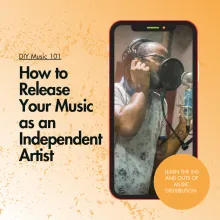
How to Release Your Music: A Guide to Independent Online Music Distribution
Have you ever wanted to release the original music you’re creating? It can seem overwhelming as an independent musician, but many artists are successfully releasing their music on major streaming platforms without the backing of major labels. Here’s a brief guide to the ins and outs of music distribution.
Planning Ahead
To adequately promote your music releases and concerts, you need to start early. Avoid scheduling your release date until you have your masters in hand to ensure that you have enough time to plan your marketing. It is not uncommon for artists to have their finished albums 3-6 months in advance of the release so they can send them out to blogs, radio stations, and labels.
Creating The Song
Once your song, EP or album is complete and has been mixed and mastered, you’ll be ready to release your music for the world to hear. The first step is to ensure you have your music saved as a high-quality WAV or MP3 file.
Designing Cover Art
The cover art for your music plays a vital role in capturing attention and setting the tone for your release. Whether it's a single, EP, or album, having compelling cover art is essential. You have various options when it comes to creating your cover art. You can create one yourself using personal photographs, paintings, drawings, or digital art tools like Canva or Adobe Illustrator. Alternatively, consider collaborating with an artist to design a custom album cover that aligns perfectly with your music's vibe and message.
Choosing a Music Distribution Service
To distribute your music to major streaming platforms like Spotify and Apple Music, you'll need a music distribution service. Popular options include DistroKid, CD Baby, and TuneCore, each offering different features and subscription plans. It’s best to do some research to learn which one is best for you based on your release strategy and budget.
Uploading and Providing Metadata
When uploading your music to a distribution service, you'll need to provide essential metadata such as song title, artist name, album name (if applicable), release date, and genre. Accurate metadata ensures your music is properly categorized and searchable.
Exploring Free Alternatives
Releasing music independently doesn't always have to involve paid distribution services. Popular free alternatives for distributing your music include YouTube, Soundcloud, and Bandcamp. These platforms allow you to gauge audience response before pursuing major streaming services.
Register Your Music
Make sure your music is protected and ensure you receive all your royalties by registering with these key organizations:
Performing Rights Organization PROs (ASCAP/BMI): Get paid whenever your music is performed.
SoundExchange: Collects royalties for sound recordings played on platforms like Pandora.
The MLC: Register for mechanical royalties from streaming services.
Copyright Office: Protect your music with copyrights for both sound recordings and compositions.
Spotify for Artists
If you choose to distribute your music on Spotify, create a Spotify for Artists account. This will give you access to valuable insights and tools for promoting your music on Spotify.
Release Your Music!
It can be intimidating to release music, but approaching your music release with thorough research, strategic planning, and a passion for your art, you'll be well-prepared to launch your music as an independent artist.


